new posts in all blogs
Viewing: Blog Posts Tagged with: bob dylan, Most Recent at Top [Help]
Results 26 - 50 of 51
How to use this Page
You are viewing the most recent posts tagged with the words: bob dylan in the JacketFlap blog reader. What is a tag? Think of a tag as a keyword or category label. Tags can both help you find posts on JacketFlap.com as well as provide an easy way for you to "remember" and classify posts for later recall. Try adding a tag yourself by clicking "Add a tag" below a post's header. Scroll down through the list of Recent Posts in the left column and click on a post title that sounds interesting. You can view all posts from a specific blog by clicking the Blog name in the right column, or you can click a 'More Posts from this Blog' link in any individual post.
 |
| Me and a Gun |
It's not Bob Dylan's best by any means, but for quite a while I've had a fondness for his little-known early folk song,
"Let Me Die in My Footsteps", which I first heard in a recording by
Happy Traum (with Dylan in background) from the
Best of Broadside album, a marvelous collection that I gave to my mother as a Christmas present ten years ago.
When I first heard the song, this verse is one that quickly stuck in my mind, and is one that has a habit of floating through my mind's ear with some regularity:
If I had rubies and riches and crowns
I’d buy the whole world and change things around
I’d throw all the guns and the tanks in the sea
For they are mistakes of a past history
It was a constant earwig this weekend after I learned of the
massacre in Arizona.
I think John Scalzi, among others, has
sensible things to say about the politics of all this -- it's entirely likely that Jared Loughner was, in a vernacular sense at least, "crazy", but the national conversation has turned, for good reason, to the violence implied by much right-wing rhetoric -- and overtly stated by slightly less such rhetoric.
I have lived most of my life in a state where it was recently
declared legal for people to carry guns in the State House. I lived for the first 18 years of my life with a gun shop attached to my house. When my father died in 2007, I inherited that gun shop, and had to get a Federal Firearms License to sell off the inventory. I know the gun culture in this country well, because though it's never held much appeal for me, it is a world I have never fully escaped. Mine has not been a world just of hunting guns, either; I shot my first machine gun when I was about 9 years old, maybe 8. (I've written about all this in some detail in
my Rambo II essay.) I still have many well-armed friends, some of whom, in fact, I sold guns to.
Despite my left-wing tendencies in nearly every other realm, I'm not a big fan of most gun control proposals and legislation, but my reasons for not being a fan would probably cause people more comfortable with our gun culture to label me anti-gun -- most of the legislation seems to me ineffective. Dylan's utopia in "Let Me Die in My Footsteps" is one I fiercely yearn for -- a world of no weaponry.
But that's a utopia, and while utopian thinking has its place, I don't think it should be the base of legislation.
Ours is a nation of hundreds of millions of guns legally owned by civilians. It's just about impossible to know how many illegal guns are out there in addition to the hundreds of millions legally available. That's not a fact you can just legislate away, and broad attempts to do so only play into the fears of gun owners who think the government wants to take their guns -- and playing into those fears just causes more people to h

By:
tara,
on 10/20/2010
Blog:
Tara Lazar
(
Login to Add to MyJacketFlap)
JacketFlap tags:
Robert Hilburn,
PiBoIdMo 2010,
Corn Flakes with John Lennon,
Man Gave Names to All the Animals,
Children's Books,
Picture Books,
Inspiration,
Bob Dylan,
Picture Book Review,
Writing for Children,
Add a tag
Venerable LA Times rock critic Robert Hilburn recently penned Corn Flakes with John Lennon and Other Tales from a Rock n’ Roll Life, a revealing memoir-style series of vignettes featuring the great rock icons of the last 50 years.
In the book, Hilburn recounts his seven-piece Times series on the most influential and prolific songwriters of the rock era, which was published earlier this decade. He chose Bob Dylan as his first subject. Hilburn wanted to learn about a songwriter’s creative process: what inspires them, how they begin to lay down the music and lyrics, if success or failure of past work influenced future songs. The interview with Dylan earned Hilburn his third Pulitzer Prize nomination. And, Dylan’s words may give other writers—perhaps even picture book writers—inspiration for their own work:
 “Some things just come to me in dreams,” Dylan told Hilburn. “But I can write a bunch of stuff down after you leave…about say, the way you are dressed. I look at people as ideas. I don’t look at them as people. I’m talking about general observation. Whoever I see, I look at them as an idea…what this person represents. That’s the way I see life. I see life as a utilitarian thing. Then you strip things away until you get to the core of what’s important.”
“Some things just come to me in dreams,” Dylan told Hilburn. “But I can write a bunch of stuff down after you leave…about say, the way you are dressed. I look at people as ideas. I don’t look at them as people. I’m talking about general observation. Whoever I see, I look at them as an idea…what this person represents. That’s the way I see life. I see life as a utilitarian thing. Then you strip things away until you get to the core of what’s important.”
And picture books are indeed about what’s important; every picture book features an emotional truth, whether it be about family, friendship or fitting in. If you strip away what’s on the surface—the pirates or the penguins or the princesses—what remains is a story about the human experience.
Noted illustrator Jim Arnosky found inspiration in Dylan’s music. “From the first time I heard [Man Gave Names to All the Animals], the lyrics created pictures in my mind of a land of primeval beauty,” said Arnosky. Dylan gave his permission to create a picture book, and the work was released by Sterling in September.
So that’s your inspirational thought for the day. Well, two inspirational thoughts! People and songs.
What do other people’s actions say to you? How do those actions translate to story? What music boosts your creativity?
And don’t forget, there’s much more inspiration to come when PiBoIdMo begins in November. Consider this a warm up, or as Dylan might say, a sound check.




 7 Comments on A PiBoIdMo Warm-Up with…Bob Dylan?, last added: 10/20/2010
7 Comments on A PiBoIdMo Warm-Up with…Bob Dylan?, last added: 10/20/2010
By Phoebe Vreeland, The Children’s Book Review
Published: September 16, 2010
 MAN GAVE NAMES TO ALL THE ANIMALS
MAN GAVE NAMES TO ALL THE ANIMALS
By Bob Dylan (Author), Jim Arnosky (Illustrator)
Reading level: Ages 4-8
Hardcover: 32 pages
Publisher: Sterling; Har/Com edition (September 7, 2010)
Source: Publisher
I had been trying to introduce Bob Dylan to my four-year-old daughter with entirely the wrong song. Clearly, dancing around the house together to Dylan’s “Everything is Broken” was a crazy idea. Recently, Bianca Schulze handed me the new children’s book Man Gave Names To All The Animals—a beautifully illustrated picture book by Jim Arnosky with Bob Dylan’s lyrics as text. The book includes a CD of the original recording with its jumpy island beat and soft female background vocals. With the right groove and stunning pictures, a new Dylan fan is born.
Few adult Dylan fans rave about this song from the 1979 release Slow Train Coming, but the song actually lends itself well to a sing-a-long with its simple chorus and predictable rhymes. While repetitive, it won’t become an annoying ear bug like so many kids songs can. Those new to the song may appreciate the book’s text since Dylan’s signature gruff, nasal vocals are at times hard to understand. It’s a playful song and children will delight while calling out the animals’ names.
However, the true reason why I am happy to have discovered this book is it brought Jim Arnosky to my awareness. As a mother of a four-year old daughter I read a lot about pink princesses and cuddly creatures. It’s refreshing to have discovered someone who is passionately committed to connecting children with the natural world. Arnosky has written and/or illustrated over a hundred books about nature—books with titles like Slither and Crawl, Crocodile Safari, and Every Autumn Comes the Bear.
Using nature as the underlying theme, his books are as varied as they are plentiful and appropriately adapted to all ages. He has reached the very youngest with his “Mouse” series of picture books and the adorable Rabbits and Raindrops and Otters Underwater. Arnosky writes books for the older child that draw him out into the natural world while engaging in it—teaching outdoor skills, identification, sketching or merely observing—inviting them to “see as an artist would and observe as a naturalist would.” He has been praised for not romanticizing or humanizing animals. Influenced by the great nature writers John Burroughs and Ernest Thomas Seaton, Arnosky has said that their writings enticed him out into the natural world and he hopes his books will do the same for others.
Living and working in a rural Vermo
“In this age of fibreglass I’m searching for a gem”
Planet Waves
B. Dylan
I don’t know who started it or how it started but it became a tradition and a ritual. We (Dave, Robin, Frank, Norm, Paul, Al and Mike to name some of the main participants) lived in a house on the corner of 4TH Ave and Balaclava in the Kitsilano neighbourhood of Vancouver. They say it has become very exclusive and expensive there now. Then we had a single mother with an almost teenage daughter living next door to us. She was convinced that the RCMP (she called them “The Horsemen”) had killed her husband who had been a heroin dealer.
The tradition was turning a Saturday (if we were working or any afternoon if we weren’t) into a Tequila Sunrise or Bloody Caesar or Harvey Wallbanger day. We all supplied the ingredients if we could plus whatever beer and smoke were available, threw open the doors and windows and cranked up the stereo.
It is incumbent upon residents of Vancouver to take advantage of every sunny day there. Even the British climate doesn’t seem as depressing as the long, grey, cold, wet stretches of days and weeks which occur in Vancouver winters. Maybe it’s not so bad for natives but we weren’t natives and knew very few. Everyone was from somewhere else.
I remember Meddle and Band on the Run and Peaceful Easy Feeling blaring out across the postage stamp lawn as we played frisbee or catch with a football.
The one which was played the most on those days was Planet Waves.
It was the last time Dylan recorded in a studio with The Band. They had already toured with him as The Hawks and they toured again in support of Planet Waves. Not a bad backup band.
They honed their chops in Toronto backing up Rompin Ronnie Hawkins, The Hawk.
In The Last Waltz (1978) Robbie Robertson describes Ronnie Hawkin’s pitch upon hiring the talented teenagers as something like, “the money ain’t great, but you’ll get more pussy than Frank Sinatry”.
The Hawk was from the southern US and had plenty of experience in small bars there where the band onstage was separated from the audience by chicken wire to protect them from missiles like beer bottles thrown their way. He says he was a hard taskmaster. He didn’t want a backup band which learned songs on stage or made a lot of mistakes. He made them practice and practice hard.
The Hawk was recently interviewed by George Stroumboulopoulis on Canadian tv about his miraculous recovery from pancreatic cancer. A young healer (an underground healer, one not recognized by the established system) heard of his plight and helped him recover. Now he’s still laughing about the miracle and, as he tours, sharing his joy.
The best known song on Planet Waves is Forever Young. It’s obvious when you listen to the lyrics why Rod Stewart covered it. I don’t know whether he added some words of his own, but every parent, rock star or not, can understand the sentiment behind the lyrics of the song.
On side 2 of Planet Waves The Band whipped up one fast version with their electric jug band style, but the slow version on side 1 with Robbie Robertson’s tasty licks is one of the best rock songs ever written in my opinion.
I know some people can’t stand Dylan’s music and his voice even though it’s in key and timed properly, but anyone who admires the power of the English language has to, at least, respect him as a writer.
“Twilight on the frozen lake, North wind about to break...” are ten words which open Never say Goodbye and an instant image is conjured up in the listener’s mind.
Planet Waves also contains Going, Going, Gone which is another song created with great lyrics and the collaboration of musicians which doesn’t overpower the lyric content. It is a good example for all b
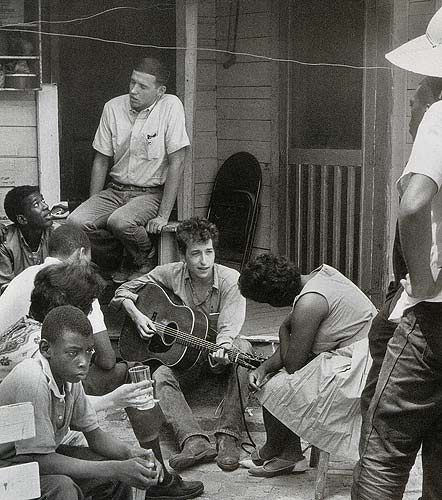
photo source.
The one-and-only self-proclaimed Archbishop of Anarchy is 69 years old today!
And there simply is no stopping him. After a two-month break, Dylan will launch yet another overseas tour, opening on May 29th in Athens, Greece.
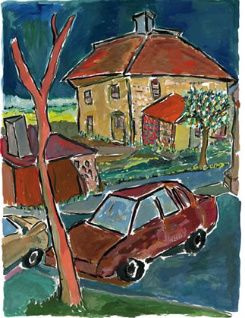
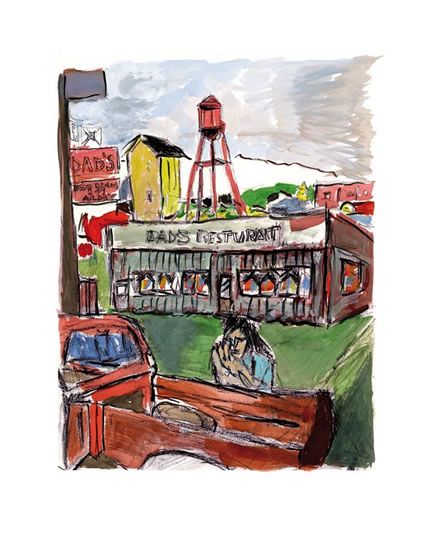
"Backyard" and "Dad's Restaurant" from the 2010 Drawn Blank Series.
On May 22nd, his 2010 Drawn Blank Series was officially unveiled in the Castle Galleries, U.K. This is the third collection of limited edition graphics available for purchase following unprecedented worldwide acclaim and demand. The series is limited to 295 pieces signed by the artist (more info here), and are impressions of people, places, and things he encountered while on the road. How much do I love that he sketched the exterior of a restaurant?!
Meanwhile, stumbled upon a couple of fascinating old photos.
Here's Dylan with one of his sons and George Harrison. You idolize someone and judge him by his public persona, oftentimes forgetting he's a family man doing "ordinary" things.

from dag's photostream.
And okay, let's just stand around and shoot the breeze with Neil Young and Eric Clapton. *swoon*
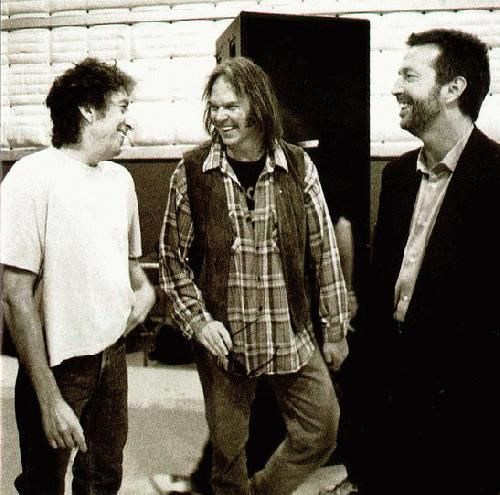
from dag's photostream.
I've noted that Sony Entertainment and others have removed hundreds of Dylan videos from YouTube.com -- amateur videos of concerts, fan-made compilations, bootleg copies of official videos, etc. They're cracking the whip on copyright infringement and now there are only a handful of videos available for public viewing and sharing (prefaced by annoying Vevo ads). I like this one from 2000, "Things Have Changed". Dylan shows off his dramatic flair (love the way he holds a sandwich, and the bits in the coffee shop), and there are some fun cameos by Katie Holmes, Michael Douglas, and Robert Downey, Jr., among others. Enjoy!
Now, go forth and crank up your fave Dylan song. Just for today, your response to all questions: "The answer, my friend, is blowin' in the wind." Alternately, if you're feeling especially frisky, approach a stranger with, "How does it feel?"
Connect, engage, cherish the humanity!
View all posts tagged Bob Dylan here.
Copyright © 2010 Jama Rattigan of jama rattigan's alphabet soup. All rights reserved.
Last week, PBS aired, "In Performance at the White House: A Celebration of Music from the Civil Rights Movement." This special program was hosted by President and Mrs. Obama in honor of Black History Month, and featured readings from famous civil rights speeches and writings in addition to songs performed by such luminaries as Smokey Robinson, Yolanda Adams, Jennifer Hudson, Joan Baez, and Bob Dylan.
Bob was in fine voice that evening with "The Times They are a Changin'." It's a softer, more subdued acoustic version, quite poignant in these difficult times. I thought about where we were as a nation when the song first came out in the 60's. These days, we have an African American President in the White House listening to it with his family. I wonder what he was thinking, and whether Dylan was at all nervous.
If you missed the original broadcast, you can view it in its entirety at the PBS website. Well worth your time!
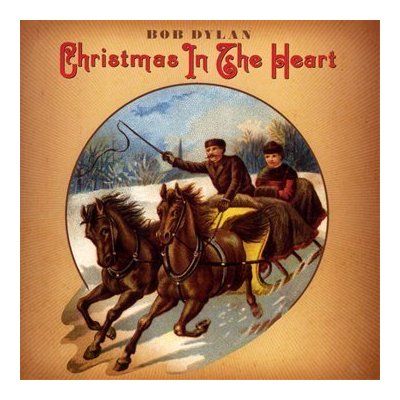
Ho ho ho and a jingle jangle morning to you!
My favorite song and dance man has put out a Christmas album!
Go out and purchase Christmas in the Heart pronto, because:
♥ you will help fight hunger in America -- 100% of the artist's royalties will go to Feeding America, the nation's leading domestic hunger-relief charity, which works through a network of member food banks.
♥ that's a guarantee of 4 million meals to 1.4 million people in need, including children and seniors.
♥ Dylan has also partnered with two international charities (Crisis and the World Food Programme) to provide meals during the holiday season for the needy in the U.K. and 80 developing nations around the world.
♥ all royalties will be donated to Feeding America and the international charities in perpetuity (foreverness)!
♥ this is one funky collection of holiday favorites: who'd have thought in a million years the self proclaimed Archbishop of Anarchy would go all traditional and adeste fidelis on us?
Dylan sounds like your favorite uncle on this CD, hitting hard on the eggnog and making merry, and comes across as surprisingly "normal." My favorite tracks: "Must Be Santa," "Christmas Island," "Winter Wonderland." Nothing weird or experimental here -- he does the standards in a straightforward way, serving up lots of festive energy, nostalgia, warmth and fuzziness. At 68, this is Dylan's 47th album, and it definitely endears him to me in a "I'm not Bing Crosby or Perry Como but I care a whole lot about feeding the hungry" kind of way.
Check out this video of "Must Be Santa." LOVE when he sings, "Who's got a great big cherry nose?" Also his variety of hats! First video he's done of his own music since the late 90's. If this doesn't get you in the holiday spirit and dancing the polka there is something seriously wrong with you.
P.S. If you purchase the CD through one of these independent music stores, you'll receive a bonus collectible limited edition 45 rpm vinyl record (while supplies last).
Myths (so runs the myth) belong to past ages, when people were naïve enough to believe in them. Today, in scientific modern times, we’ve put away such childish things. So why bother with fantasy? Isn’t it just puerile escapism? Even children are expected to grow out of myths and fairytales, and surely any adult found reading or writing the stuff cannot expect to be taken seriously? Can fantasy really have anything meaningful to say?
These are interesting questions. Bear with me as I try to answer them in what may seem a round-about way. I’ll begin with an even bigger question:
What makes us human?
The answers to this one keep being refined. A special creation in the image of God – for centuries a popular and satisfying answer? Difficult to sustain as it became clear that we’re only one twig on the great branching tree of evolution. Language? Perhaps, but the more we study other animals and birds, the more we realise many of them communicate in quite sophisticated ways. Toolmaking? Not that distinctive, as chimpanzees and a variety of other animals employ twigs and stones as tools. Art? It depends what you mean by ‘art’ – if you think of bower-birds designing pretty nests to attract their mates, it seems clear that some animals do have an aesthetic capacity. So are we different from other animals at all?
Common sense says yes – at the very least, we have taken all these capabilities incomparably further than other animals – but is that really the best we can do for a definition? What was the point at which our ancestors became recognisably ‘us’, and in what does that recognition rest?
Innovation is one answer – the development and bettering of tools.
Homo habilis and
homo heidelbergensis lived with one basic design of hand axe for about a million years. When, on the other hand, we see signs of people messing about and tinkering and trying out new ideas, we recognise ourselves.
Related to this is another answer: symbolic thinking. Maybe some of our closest relatives are partially capable of it – a chimpanzee can recognise a drawing or a photograph, which means nothing to a dog. But wild chimps don’t indulge in representational art. Sometime, somewhere, somebody realised that lines of ochre or charcoal drawn on stone or wood could stand for a horse or a deer or an aurochs. That in itself is an amazing leap of cognition. On top of that, however, there had to be some fascination in the discovery, some reason to keep on doing it – some inherent, achieved meaning that had nothing directly to do with physical survival. What? Why?
Somewhere along the line, human beings became sufficiently self-aware to be troubled by death. When you truly understand that one day, you’ll die, the whole mystery of existence comes crashing down on you like the sky falling. Why are we here? What was before us? Where did we come from and where will we go?
The ‘mystery of existence’ is an artefact. We choose to ask an answerless question, and that question is at the core of our humanity. The before-and-after of life is a great darkness, and we build bonfires to keep it out, and warm ourselves and comfort ourselves. The bonfire is the bonfire of mythical thinking, of culture, stories, songs, music, poetry, religion, art. We don’t need it for our physical selves:
homo heidelbergensis got on perfectly well without it: we need it for humanity’s supreme invention, the soul.
Karen Armstrong claims that religion is an art, and I agree with her. In her book ‘A Short History of Myth’ she examines the modern expectation that all truths shall be factually based. This is what religious fundamentalists and scientists like Richard Dawkins have, oddly, in common. A religious fundamentalist refuses to accept the theory of evolution because it appears to him or her to disprove the truth of Genesis, when what Genesis actually offers is not a factual but an emotional truth: a way of accounting for the existence of the world and the place of people in it with all their griefs and joys and sorrows. It’s – in other words – a story, a fantasy, a myth. It’s not trying to explain the world, like a scientist. It’s trying to reconcile us with the world. Early people were not naïve. The truth that you get from a story is different from the truth of a proven scientific fact.
Any work of art is a symbolic act. Any work of fiction is per se, a fantasy. In the broadest sense, you can see this must be so. They are all make-belief. Tolstoy’s Prince André and Tolkien’s Aragorn are equal in their non-existence. Realism in fiction is an illusion – just as representational art is a sleight of hand (and of the mind) that tricks us into believing lines and splashes of colour are ‘really’ horses or people or landscapes.
The question shouldn’t be ‘Is it true?’, because no story provides truth in the narrow factual sense. The questions to ask about any work of art should be like these: ‘Does it move me? Does it express something I always felt but didn’t know how to say? Has it given me something I never even knew I needed?’ As Karen Armstrong says, “Any powerful work of art invades our being and changes it forever.” If that happens, you will know it. It makes no sense at all to ask, ‘Is it true?’
Fantasy still deserves to be taken seriously - read and written seriously - because there are things humanity needs to say that can only be said in symbols. Here’s the last verse of Bob Dylan’s song ‘The Gates of Eden’ (from ‘Bringing it All Back Home’):
At dawn my lover comes to meAnd tells me of her dreamsWith no attempts to shovel the glimpseInto the ditch of what each one meansAt times I think there are no words But these to tell what’s true:And there are no truths outside the Gates of Eden.Visit Katherine's website
www.katherinelangrish.co.uk

Bob Crelin will be posting his blog entry soon.
Meanwhile, did you see how Charlesbridge and Bob Dylan have a lot in common in the previous post below? Uncanny. Bob is also of Russian descent, which makes The Magic Babushka even more Dylanesque. Plus it's an Easter story, which Bob mentions in "Just Like Tom Thumb's Blues" on Highway 61 Revisited.
Charlesbridge enters the rock pantheon with The Magic Babushka.

As you can see on this Bob Dylan album cover for Dimestore Medicine, Bob's friend (is that Sara?) is wearing her own magic babushka.


 A side-by-side comparison
A side-by-side comparison
This photo is from 1965. Dylan is a folk music hero.
The Magic Babushka is inspired by Russian folk tales and was originally published in 1998.
The Magic Babushka
by Phyllis Limbacher Tildes
ISBN 978-1-58089-225-4
Ages 5-8, Paperback, $7.95
"A poem is a naked person. Some people say that I am a poet." ~ Bob Dylan
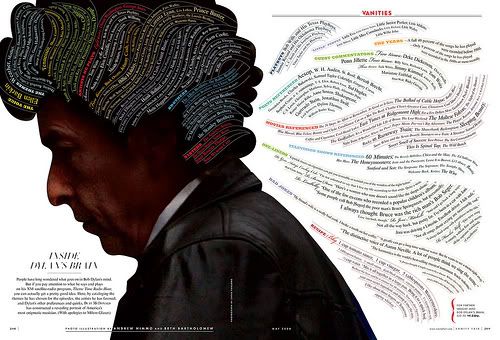
So, I simply can't celebrate National Poetry Month without mentioning my man.
Found this very cool piece in Vanity Fair by Duff McDonald, called "Inside Dylan's Brain" (click through to lopez2k95's photostream, "all sizes," to see full size version of graphic).
By cataloguing some of Dylan's themes, musical preferences, quips, quotes and other bits and pieces from his Theme Time Radio Hour show on XM Satellite radio, McDonald has given us a glimpse into the mind of the Pulitzer Prize winning song and dance man.
I like that Dylan's given advice on "How to Walk Like a Runway Model," and "How to Give Yourself Dreadlocks." He's played George Jones more than any other artist; he's mentioned Shakespeare, Poe, Joyce, Cummings, Yeats, Plath. He's pontificated on Women's Names, Shoes, Thanksgiving Leftovers and Spring Cleaning. And you gotta love a man who makes his own barbecue sauce and meatballs, and shares his recipe for Figgy Pudding. Fascinating stuff!
Read the entire list at Vanity Fair.
I also listened to "Last Thoughts on Woody Guthrie" again, and found it very moving, still relevant in these turbulent, uncertain times. This poem is the only one Dylan has ever read in public (April 12, 1963 at New York Town Hall); it's a tribute to the man who probably had the strongest influence on his music, and speaks to the crucial role the poet/songwriter/artist has in society. Eric Clapton said this about Dylan:
He's a poet. Basically he's a poet. He does not trust his voice. He doesn't trust his guitar playing. He doesn't think he's good at anything, except writing—and even then he has self-doubts. Have you heard that thing he wrote about Woody Guthrie? That to me is the sum of his life's work so far. Whatever happens, that is it. That sums it up.
I hope you'll take a few minutes to listen to it, really listen to it. Don't we all have this feeling, of wanting something or someone to believe in, looking for hope somewhere, anywhere? When we've come to the end of our rope, what can we hold on to?
You can find the poem in its entirety here.
.jpg?picon=512)
By:
Pamela Ross,
on 3/30/2009
Blog:
Born to Write
(
Login to Add to MyJacketFlap)
JacketFlap tags:
bob dylan,
celine dion,
bruce springsteen,
james franco,
allen ginsberg,
beat poetry,
howl,
carl wilson,
david amram,
Add a tag
Where I'm Coming From:
I can't say exactly what made me click on John Lundberg's blog on today's HUFFINGTON POST. Maybe it was an e-mail alert that Lundberg had uploaded a new blog. Maybe I was reading the Sunday New York Times Arts and Leisure section and something caught my eye about new movies and word of the upcoming release of HOWL, a movie starring James Franco as a young Allen Ginsberg and the obscenity trial brought in the U.S. after the poem's publication.
Or maybe it was the Google search that blipped from HOWL to Ginsberg to (how? how? I can't remember!) writing ABOUT music to watching a clip from the Colbert show with his guest, music essayist and blogger Carl Wilson (http://www.zoilus.com/) talking about his love-hate affair with Celine Dion's music in his book LET'S TALK ABOUT LOVE: A Journey to the End of Taste (pubbed in the 33 1/3 series by CONTINUUM BOOKS (and yes, they've already pubbed a Bruce Springsteen title, darn it).
Slow down. It just came to me. I chanced upon Carl Wilson's blog after a separate Google hit directed me to a YOUTUBE clip of actor James Franco talking on the Red Carpet about the book Franco was reading and loving: Yes, it was Carl Wilson's LET'S TALK ABOUT LOVE which I am SO going to buy when I have a few extra shekels; the completist in me will also have to dig in and pick up the Bruce Springsteen title which seems to be more about the BORN IN THE USA album/tour than about Bruce.
(I should also note here that in a great confluence of great worlds colliding, great actor James Franco-- have you seen him in MILK? Oh my g-d-- is the son of children's author Betsy Franco. I also learned from one of the Google hits that James Franco is taking creative writing courses at my alma mater, NYU.)
Deep breath.
Talk about following the bouncing ball! That was one long and winding road to get to what I'm really thinking about tonight but as I've mentioned time and again, half the beauty of blogging is understanding why you started writing that certain random something. It may not always make sense but when it does, I admit the connections and directions a mind travels is a wondrous thing to behold.
So. Turn the page. The journey continues. (Just see if AAA could make a better TripTik than me.) ;>
And the Beat Goes On.
Prose. Poetry. Pulse. Though not the first to get there, The Beatniks famously brought music and speech together, making jazz out of words and words out of jazz.
Makes me wish I could be a Beat Chick. Who knows. Maybe. One day.
I can't write music but I hear it. I hear it in everything I write. Even if I never intend those words to be read outloud, I don't think I can help but write with the rhythm I hear tracking in my brain.
Now would be a good time to play songs from my favorite Dylan album: BLOOD ON THE TRACKS. (Favorite song: YOU'RE A BIG GIRL NOW.) Because even if the stories I write seem confessional and drenched in real-life blood, they're not necessarily MY confessional or MY blood-- but they are the character's confessions and dripped in the blood of her voice. Think how many times has someone in your family asked you: "Did this really happen?" as if to ask you to pinpoint the date and time in your life the "fiction" you write about took place, as if all diary entries were based in reality, as if everything you write is true. No. Get it. That's why it's called art. Writing. Creativity. It happened. To Someone. Someone YOU made up from some artificial bubble that burst one day and turned into a real-life character with a real-life story to tell. If it's on the page, it's real. Play it as it lays.
Producer and composer David Amram worked with Jack Kerouac and together the made stories sing. (And what editor hasn't urged a writer to make her words sing?)
Even if the only music is in your head.
And if you take nothing else away from this jazzy, hip-hop slop of improvised thoughts today, listen to the advice offered by David Amram, speaking for the Beat Voices of another generation: Flush away people who tell you your art is hopeless. Family and friends may love you but if they tell you to the dream is not worth pursuing, you're hanging out with the wrong people. {}
Yeah, baby. That.
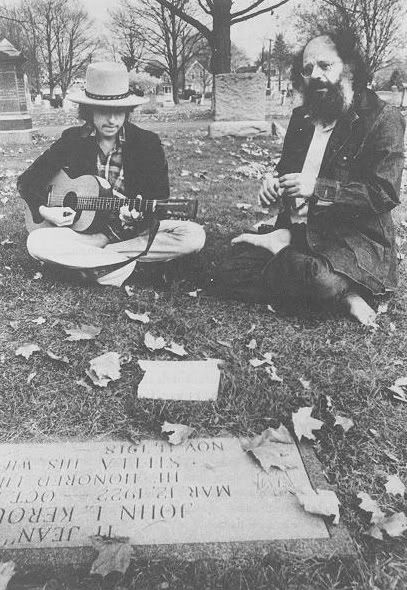
Dylan and Ginsberg hanging out at Jack Kerouac's grave
 A short while back I began doing all my "inking" in Adobe Illustrator, and I have to say I've been really pleased with the results. Here's my rendition of Dylan.
A short while back I began doing all my "inking" in Adobe Illustrator, and I have to say I've been really pleased with the results. Here's my rendition of Dylan.
See more at my website.
Mark
Boop meets Dylan, one day only! Cover by Robert James Fuller.
April 23rd: Celebrate World Book and Copyright Day...
 My IT professional brother emailed me this morning to tell me that today is World Book and Copyright Day according to UNESCO, the United Nations Education, Scientific and Cultural Organization. (Maybe I should have brought cupcakes to work. Every celebration need cupcakes.)
My IT professional brother emailed me this morning to tell me that today is World Book and Copyright Day according to UNESCO, the United Nations Education, Scientific and Cultural Organization. (Maybe I should have brought cupcakes to work. Every celebration need cupcakes.)
The UNESCO website says that on this date in 1616, Cervantes, Shakespeare and Inca Garcilaso de la Vega all died. April 23rd is also the birthday or death date of other noted authors like Maurice Druon, K. Laxness, Vladimir Nabokov, Josep Pla and Manuel Mejía Vallejo.
The purpose of World Book and Copyright Day, says UNESCO, is "to promote reading, publishing and the protection of intellectual property through copyright." Sound good to this editor.
P.S. The theme of Bob Dylan's radio show today: birds--all songs about birds.
P.P.S. My brother just emailed me again to say that it's also National Jelly Bean Day and National Cherry Cheesecake Day. (When is National Cupcake Day?) Apparently my brother is not very busy at work.
Vijaya Bodach tagged me for the Nearest Book meme. Given that I'm about to leave for two weeks overseas and have a googillion (to quote Ben Stiller) things to do, I almost didn't do this. But I don't like to let people down, and I'm always happy to see my writing friends start blogging (Vijaya's a brand new blogger--yea!) so here goes:
These were the rules:
1. Pick up the nearest book.
2. Open to page 123.
3. Find the fifth sentence.
4. Post the next three sentences.
I have two books equally near: Bob Dylan's
Lyrics and Rachel Cohn & David Levithan's
Nick & Norah's Infinite Playlist. But
Lyrics is on top, so I'll use it.
Page 123 is the middle third of Dylan's song Motorpsycho Nightmare. It's not in sentences, so I'm going by lines instead.
"...Today I drove"
He said, "I got a bed for you
Underneath the stove"The farmer goes on to tell Dylan (or the narrator of the song) that he can sleep there under one condition. Don't touch his daughter. So Dylan's sleeping when the daughter wakes him up. This is too funny:
There stood Rita
Lookin' just like Tony Perkins
She said, "Would you like to take a shower?"Ha! OK, I have to confess I'm struggling through this book, though. I consider many song lyrics to be fine poetry, but I find little rhythm, pacing, and beauty so far in Bob's words. I know! The man just won a Pulitzer! Millions of fans and musicians worship him. So I'm sure it's me. But picking this up and reading it as a poetry collection, well, it's just not doing it for me. Maybe I need the music but just not his annoying voice.
Anyway, I'm supposed to tag five people. But I've been sketchy on blog reading the past two weeks due to deadlines and trip preparation, so I've been aware of this making the rounds but haven't followed who's already done this. I'm going to tag my
crown sonnet mates (any who haven't already done it), plus
Jama Rattigan, because Bob makes me think of her.

It just may be here: My favorite season of the year.
Serious melting has begun and it's time for sloshing through ice-laced puddles.
For me, Spring in Smalltown is a great joy. To go from the cold white to a multitude of colors--some breaking through before your very eyes--is a wonder I never experienced when living in the Golden State. I love the flowers, the greening of the grass, the warm air, and even the violent thunderstorms. Bring it on!
Mary Jo Salter's "Spring Thaw in Hadley" portrays the miraculous chaos of this time of great beauty. Here are a few lines from the poem:
By noon, the ice as thin
as an eggshell veined to show
life seeping yellow,
one’s boots sink in
with a snap; the sap
underrunning everything
may be nothing but water, yet
there’s a sacramental
joy in how, converting
to its liquid state,
it’s anything but gentle.
...you can read
the poem in its entirety here at PoetryFoundation.org.
---------------------
Jama Rattigan is on the round up and asks you to share your favorite Bob Dylan lyric if you'd like. (Oops! Time to improvise...)

I'll share some lyrics from a Bob Dylan song I like very much, but don't really understand at all: "One More Cup of Coffee for the Road." This song just speaks to me, I wonder why?
Your sister sees the future
Like your mama and yourself.
You've never learned to read or write
There's no books upon your shelf.
And your pleasure knows no limits
Your voice is like a meadowlark
But your heart is like an ocean
Mysterious and dark.
One more cup of coffee for the road,
One more cup of coffee 'fore I go
To the valley below.
You can read the whole song here.
(I have no idea what this song means, but I like it anyway. The rest of the lyrics are even more opaque.)
---------------
Photos from
FreeFoto.com
Okay. Wake up. It's all right. It's all right. You're safe.
I just had a horrible dream.
I met someone in a concentration camp.
He was a musician and actor. Someone Almost Famous.
I remember him wrapping a sheet around me. As if to hold me close. Keep me warm.
We fell in love. (Survival instincts make strange bed-fellows.)
I remember the kiss that sealed our fate.
And we knew we had to run. We held hands, our thin cloth coverings wet and dirty and flapping in the rain. I was barefoot. I remember the feeling of the mud drenching and swallowing my toes, slowing me down. He kept running.
And there are the Nazis chasing me through the forest, Nazis holding me down, making me scream my allegiance to Hitler as the guns are drawn and I am sobbing.
It's not good to cry on your birthday.
Very superstitious. {}
The day can only get better-- if you call going to the dentist for major mouth surgery "better." I know. Could he have picked a worse day and told me "That's all I have"? He made me an offer I couldn't refuse. ;}
Thanks to you for the lovely thoughts here (can LJ entries be copied and pasted from one entry to another?) and in e-mail.
I need to erase this nightmare from my memory. Too real, too painful.
May God bless and keep you always,
May your wishes all come true,
May you always do for others
And let others do for you.
May you build a ladder to the stars
And climb on every rung,
May you stay forever young
Added to edit after posting: Too bizarre. Check out the time this entry was posted on Live Journal. 3-0-6. Shiver me timbers! Oy! Seriously unplanned but maybe it's a sign.. The Powers that Be work in Mysterious Ways. Is it too early to start drinking? I have a feeling it's going to be ONE OF THOSE DAYS.... ;}

.jpg?picon=512)
By:
Pamela Ross,
on 3/2/2008
Blog:
Born to Write
(
Login to Add to MyJacketFlap)
JacketFlap tags:
reading,
birthdays,
dr. seuss,
editors,
book donations,
bob dylan,
emily dickinson,
springfield,
writing influences,
bat mitzvah planning,
emily dickinson,
writing influences,
bat mitzvah planning,
springfield,
Add a tag
Are any of your books loooking for a new home? Here's a novel idea. Pun intended. It's awkward it never occurred to me before: bring your books to homeless shelters. Head on over
to the ABC news site for an eye-opening piece on book clubs forming in these shelters. In my book, food, clothing, and shelter provide the traditional necessities, but let's not forget that other basic need: to read, to connect, to share, to see ourselves in stories and to feel less alone.
From the article:
"At a time when book-reading is declining and is especially low among poorer people according to a recent Associated Press-Ipsos poll, the book club at 2100 Lakeside seems ill-fated. But, while 1 in 4 people polled admitted to having read no books in 2006, homeless men here are reading two a month."

I know I am preaching to the choir when I say there "is no frigate like a book." (Why argue with Emily Dickinson?)
There is no frigate like a book (1263)
by Emily Dickinson
There is no Frigate like a Book
To take us Lands away,
Nor any Coursers like a Page
Of prancing Poetry –
This Traverse may the poorest take
Without oppress of Toll –
How frugal is the Chariot
That bears a Human soul.
Many moons ago, I found refuge in the pages of a book. That was X thousand books ago as well. (Numbers schmumbers.) One of the first books I ever read to myself-- and then to my parents-- was AND TO THINK THAT I SAW IT ON MULBERRY STREET. The man who launched 10,000 children's book editors pleas for "No Dr. Seuss imitators" celebrates his birthday today, March 2nd. Happy Birthday, Theodor Seuss Geisel. I'll always love you. Not green eggs. Not ham. (The food. LOVED the book.) When I realized I Could Read it Myself, hello, I found nirvana and I never, ever looked back. Not sure what would have become of me but I suspect none of it would have been good.
I guess you could say what I found on Mulberry Street was... me.

Dr. Seuss, still looking good at 104
P.S. Seuss's Mulberry Street was in Springfield, Massachusetts, Geisel's birthplace. Not the infamous Mulberry Street in Little Italy more familiar to residents of the New York area. In a 6 Degrees from Kevin Bacon way, it pleases me to know I touched Seuss DNA somewhere, sometime in the course of the six years I lived in Springfield, Mass. His love was in the air. Everywhere. And now that I look back on those years, I sort of miss Springfield, too. Oh the things I could think about, all those things that happened in my life in Springfield. But that's another story.
"Nothing," I said, growing red as a beet,
"But a plain horse and wagon on Mulberry Street..."

As the Good Book says, according to Dr. Seuss:
“Today was good. Today was fun. Tomorrow is another one.”
(In truth: today was okay. Too busy for a Saturday. A little too much pressure and angst. But tomorrow is another one and another chance to make it better. You know, as in Hey Jude... "Then you can start to make it better..." I'm here, I'm not. I know. I'm lost in the bowels of parenting and real life and calendars and checkbooks. Wake me up when the bat mitzvah's over.)
Don't ask. It's all right, Ma. Just accept. Yes. That's Bob Dylan. Must See Hava Negila. ;>

Why oh why did I quit taking guitar lessons?
(There's a good story there. It involves outing a family member who wishes to remain anonymous in this semi-professional writer-to-writer journal.) ;>
But oh! This kid is on the right path.
Long may she play.
Guaranteed to make you smile. Laugh. And sing along.
That's what a great song can do.
All across the universe (tipping my hat to the Beatles, of course), great words resonate and make sense to people of all ages.
I surround myself with books, hundreds of books (I Can't Stop Buying Them... Save Me Somebody) and pray for the magic in the paper to seep into my skin. I am their assistant. I tap tap tap and hold my breath, willing the trick to work. Presto change-o. Make my words appear. Shazam!
Aint woiyds grand? Where would we be without them?


Thanksgiving is a hit-or-miss holiday for me -- I've had some wonderful ones with friends and family, but some of my favorite Thanksgivings have been ones where I've hung out on my own and taken a break from everything. This year was one of those, and a memorable one, because I decided to see two movies I was sure would be interesting to see together: I'm Not There and Across the Universe.
Both films are based on the work of some of the most recognizable, revered, and influential musicians of the last fifty years: Bob Dylan for I'm Not There and The Beatles for Across the Universe -- musicians who came of age and influence at roughly the same time. Both films are helmed by idiosyncratic directors: Todd Haynes and Julie Taymor. Both films have gotten wildly divergent responses from viewers.
I am far more of a Bob Dylan fan than a Beatles fan (though I did go through a bit of Beatlemania as a kid, and so most of the words to their best-known songs come immediately to mind if I hear only a few notes). I am far more of a Julie Taymor fan than Todd Haynes fan (his films often seem thoughtfully imagined, intelligently constructed, and mostly lifeless to me). I went into each movie trying to watch it as an artifact of its own, something toward which I would bring as few preconceptions as possible, for fear of being disappointed about either a director I respect or a body of music that has been important to my life. In particular, I wanted to see the movies as movies, not as movies about Dylan or the Beatles.
It proved impossible to watch I'm Not There without always thinking about Dylan. That shouldn't be surprising for a film that says it is "inspired by the music and many lives of Bob Dylan", but still -- I had read Anthony Lane's review, and even without seeing the movie I knew there was no way anyone could enjoy it if they had such a literal, flatfooted approach as Lane did. I had thought the best way to really enjoy the movie was not to try to connect the dots between Dylan and the kaleidoscopic hallucination of his life and music that the film presents, but rather to enter into the hallucination, to let it go without reference to anything other than itself.
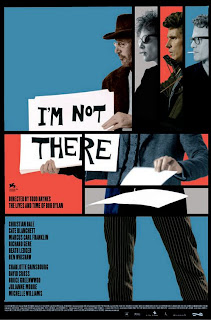 Easier said than done. And not necessary, either. Here's the thing you need to be able to enjoy this movie: you need to like Bob Dylan's music. If you don't, you're doomed, because that music plays almost constantly through the film. But if you like Dylan's music, you've got a chance. You then need to watch the movie the way you listen to a Dylan song, with an open mind and a willingness to not get all the references, but to enjoy their presence nonetheless. Instead of making a biopic, Todd Haynes has made the cinematic equivalent of a Dylan concert.
Easier said than done. And not necessary, either. Here's the thing you need to be able to enjoy this movie: you need to like Bob Dylan's music. If you don't, you're doomed, because that music plays almost constantly through the film. But if you like Dylan's music, you've got a chance. You then need to watch the movie the way you listen to a Dylan song, with an open mind and a willingness to not get all the references, but to enjoy their presence nonetheless. Instead of making a biopic, Todd Haynes has made the cinematic equivalent of a Dylan concert.
Dylan has often been described as a magpie (or, less charitably, a thief), and what Haynes has done is similar -- he has taken not only Dylan's life and work, but many of his influences, and from them he has built his structure out of riffs and allusions, quotations and transpositions, dreams, fantasies, rumors, myths, and the iconography of an array of cultural moments. Haynes has a semiotics habit, and he deconstructs one sign after another, sticking them all up on different posts to point the way toward something ineffable. (A town called Riddle figures prominently.)
Very little in I'm Not There is a one-to-one allusion where x = y. Instead, in the best moments, like some of the best moments of Dylan's best songs, the allusions are so many that they gain weight of their own -- the gravity of synergy, perhaps -- and so we have, for instance, scenes that reference Fellini, A Hard Day's Night, Don't Look Back, and much more. Such scenes become so overdetermined that the references don't really matter, except for a chuckle or nod, and we are left to consider that first-and-last refuge of the inveterate postmodernist: the surface.
Something else Haynes has done is show us how powerful the music is. (Not that those of us who have spent much of our lives listening to Dylan ever really needed anybody to tell us the music is powerful -- but I'm Not There provides the sort of defamiliarizing jolt that reminds us what resides within those notes and words.) Both I'm Not There and Across the Universe succeed by letting the music do the emotional work, but not (usually) in the crassly manipulative way of so many middling movies, the kind that underscore every climax with strings, treating their audiences like a kennel of Pavlovian dogs. I'm Not There busts its main character into six personas and tells a nonlinear, associational story with a panoply of film stocks and styles. That's a recipe for an intellectual adventure, not an emotionally satisfying experience, and while I don't think all art needs to be an emotionally satisfying experience, the evocation of emotion within nonlinear, associational forms is, it seems to me, a great artistic accomplishment -- one I appreciate in everyone from Joseph Cornell to David Markson, Virginia Woolf to Paul Celan.
The music in I'm Not There works as a link and a lifeline, a depth charge blowing the images and story to bits, leaving a ghost of electricity to shock us. All of the characters are more glimpses than they are full people, though some, because they fit into the cozy outlines of a more familiar biopic, fill up on our extrapolations. Scenes of loss and loneliness become immensely powerful not because we have any real dramaturgy warming us up for emotional exercise, but because the music is deployed so skillfully that it combines with the images to give us more information than we would ever have otherwise, and it provokes a reaction.
Haynes shifts cinematic tones again and again throughout the film, but the music remains that of Dylan, and even the songs that are performed by other musicians are mostly so faithful to his versions that the soundtrack eases us over bumps that should, by all rights, be more upsetting. Pastoral scenes alternate with parodies, goofy surrealism keeps close company with historical reconstructions. It shouldn't work. It does.

Across the Universe shouldn't work, either, but it does. Unlike I'm Not There, Across the Universe tells a linear story, but it is almost as out of the ordinary, because the story it tells is episodic and even occasionally epic, containing big musical numbers (with precise and sometimes wondrous choreography), psychedelic set-pieces, moments of quiet intimacy, caricatures side-by-side with characters, and a hippie-dippy love-conquers-all ending. What's not to love?
Julie Taymor is a wonderfully visual theatrical artist, but she has not yet had a movie that allowed her to express her visual talents as fully as Across the Universe does. I love both Titus and Frida for their exuberance and the depth of their designs, but Across the Universe goes even farther, giving Taymor the opportunity not only to work with two-dimensional backgrounds, extraordinary props and costumes, masks, and other elements present in her previous films, but also with giant puppets and extended scenes of bizarre fantasy (some of this is visible in a few of the film's YouTube clips, such as with Eddie Izzard as Mr. Kite. I was particularly happy to see Taymor get to use puppets based on those of Bread & Puppet, with whom she studied briefly.)
The characters in Across the Universe are more developed than those of I'm Not Here, and the music serves a more familiar purpose, a purpose common to most musicals: it cuts in when the characters are in the grips of strong emotion or they need to express themselves more forcefully. Here, too, though, the songs provide a particular richness to the film, because the story is generally predictable and sometimes feels composed of outtakes from Forrest Gump, but almost every bit of it is redeemed by the imagery and the music (I don't think the brief war scenes quite come off -- they don't feel much different from the other scenes in the film, when really, to motivate much of what happens, they should hurt more).
The two films overlap in their suspicion of idealism. The folk song era is portrayed in I'm Not There through gentle parody, with the tales of the young and earnest Dylan figure told in a documentary style that calls to mind A Mighty Wind and Bob Roberts more than No Direction Home. The protagonists move farther and farther away from commitment (of all sorts), though they are chased and hounded by interviewers and authorities who try to make them bow down or take a stand. In Across the Universe, the ravages of the Vietnam war radicalize Lucy until she almost loses sight of everything, and everybody who believes fervently in a cause -- whether soldier or civilian -- gets beaten, broken, bombed. The survivors in Across the Universe are the folks who never went too far, or if they did, they turned around before too late. Via different paths, the two films seem to support an ideology of transcendental individualism: Nobody gets to change the world, but they do get to change themselves, and if enough selves change, then the world changes, too.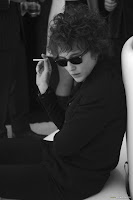
Because I was so taken by what the writers, directors, and designers of these two movies accomplished, I have said little about the performers, but each film is well performed and sometimes extraordinarily performed. (From I'm Not There, Marcus Carl Franklin and Cate Blanchett deserve particular accolades.) I was particularly surprised by Bono in Across the Universe -- he's a riot, and, at least until he sings, nearly unrecognizable. The young actors in the main roles all perform with great energy and commitment, making scenes that would have induced cringes of embarrassment were the actors less confident into real delights.
Delight, in fact, is what I felt after each film. I'm Not There is overall a greater accomplishment, I think, than Across the Universe -- its form is more innovative, its philosophy more nuanced -- but there's really no need for such a judgment, because both movies are more entertaining and thought-provoking than all but a few of the other films produced in the U.S. this year, and each will, I'm sure, reward rewatching. In fact, I'd be happy to see both movies again tomorrow if I had time, and it's rare that I encounter one film a year I can say that about, never mind two in one day.

This video doesn't appear on YouTube so for my second off-topic posting (two in one day, oh my) I refer you to the blog of one Lucas Klauss. Mr. Klauss is currently in the New School's Writing for Children program. The piece brings to mind the brilliant, now defunct, Bob Dylan meets Dr. Seuss website we all knew and loved before its untimely demise. As Mr. Klauss says, make sure you watch up until the first song. After that, it's all gravy.
Thanks to Lucas Membrane for the link.
I read Neil Gaiman's blog nearly every day, and usually there's a few different topics addressed in each blog (with each topic being seperated by an ellipsis). I was wondering.. does Mr. Gaiman just write his almost-daily blog all at once, or does he leave some kind of blog-program running in the background and write to it when he comes across something he thinks is worth writing down? I suppose, in my mind, I have this idea of Neil being done with writing that day, and then he goes and writes a blog. But sometimes his blogs are almost schizophrenic, meaning there's (sometimes) many different subjects he addresses in each of them. So I was just wondering is all. :-) Keep up the good work on the site,-Paul.It all depends. There's no real pattern -- sometimes I keep a blog entry going until it seems long enough. Sometimes I write them in the morning before work starts, sometimes at night on the couch, and sometimes, like right now, I just go onto blogger to post in order to let anyone who's likely to read this and also send me email know that due to gmail being tooth-grindingly irritating right now, anyone who's sending email to my gmail account is getting it bounced back.
But then I think "I can't just post that. There are lots of people out there who don't give a toss about my gmail. I should at least put something else up."
So then I put up a link to "Dylan Hears a Who" --
http://www.dylanhearsawho.com/home.htm -- where you can hear what sounds astonishingly like a mid 60s incarnation of Bob Dylan singing his way through the Dr Seuss catalogue, and it will probably make you happier.




 “Some things just come to me in dreams,” Dylan told Hilburn. “But I can write a bunch of stuff down after you leave…about say, the way you are dressed. I look at people as ideas. I don’t look at them as people. I’m talking about general observation. Whoever I see, I look at them as an idea…what this person represents. That’s the way I see life. I see life as a utilitarian thing. Then you strip things away until you get to the core of what’s important.”
“Some things just come to me in dreams,” Dylan told Hilburn. “But I can write a bunch of stuff down after you leave…about say, the way you are dressed. I look at people as ideas. I don’t look at them as people. I’m talking about general observation. Whoever I see, I look at them as an idea…what this person represents. That’s the way I see life. I see life as a utilitarian thing. Then you strip things away until you get to the core of what’s important.” MAN GAVE NAMES TO ALL THE ANIMALS
MAN GAVE NAMES TO ALL THE ANIMALS 

























I apologize in advance if anybody really unpleasant finds their way here because of me linking to this post. I'm trying not to link it too widely... But it's so very sane, and well-informed, and there's distressingly little of either out there right now. Both in combination is striking indeed.
And thank you for posting it.
Thanks, Jackie. No need to apologize for linking -- I've been writing this blog for over 7 years now, and have been called pretty much every name there is to be called at some point or another during that time... It goes with the territory, and only makes me more grateful for readers like you.
I've always been partial to the Minutemen song, "Little man with a gun in his hand." It speaks directly to the idea of guns being the great equalizer. It doesn't matter how small you or your dick is--as long as you've got a gun, nobody had better mess with you.
--Eric S.